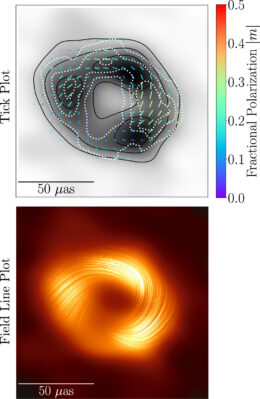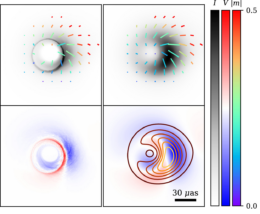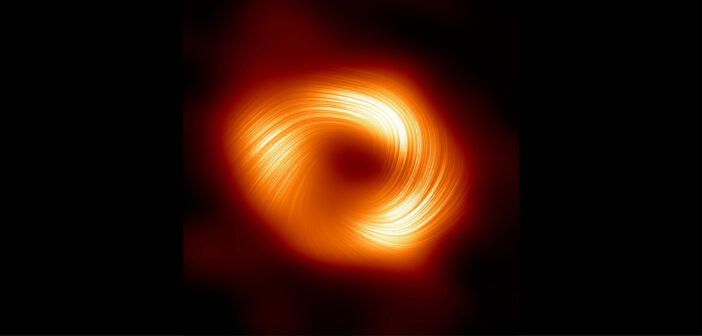In 2022, the Event Horizon Telescope Collaboration released the first image of the supermassive black hole at the center of the Milky Way. Now, the team has taken a closer look at our hometown black hole to understand the nature of its magnetic fields, the spin of its accretion disk, and more.
A First Look at the Milky Way’s Supermassive Black Hole

The first EHT image of Sgr A*. [EHT Collaboration]
These observations revealed a bright ring of emission from the superheated accretion disk surrounding Sgr A* and confirmed that it is indeed a supermassive black hole with an event horizon — a surface beyond which nothing, including light, can escape the black hole’s immense gravitational pull.

Top: Average polarization fraction for Sgr A*. Bottom: Polarization “field lines” showing the spiral pattern of the polarization angles. [EHT Collaboration et al. 2024]
From Brightness to Polarization
But the EHT did more than just measure the brightness of the glowing gas surrounding Sgr A* — it also measured the light’s polarization. As light waves wiggle through space, they can be oriented in any direction. If the light is oriented every which way, that light is unpolarized. If instead the waves are oriented along a particular plane, the light is polarized.
Hot, magnetized plasma emits linearly polarized light because the magnetic field influences the direction in which light waves oscillate. If this polarized light travels through magnetized material, the direction of polarization might rotate or become random. By analyzing the polarization of an object’s emitted light, researchers can study the strength and structure of the object’s magnetic fields and determine whether or not there is magnetized material between the source and our telescopes.
The EHT data show that the light from the hot, gaseous accretion disk surrounding Sgr A* is strongly polarized, with certain parts of the glowing disk being up to 40% linearly polarized. Some of the light — 5–10% — is circularly polarized, which means that the orientation of the waves rotates as the light travels. The polarization direction follows a distinct pattern, forming a spiral that curls around the black hole.
Measurements, Modeling, and Magnetic Fields
The amount of polarized light and the direction of polarization can help researchers disentangle the structure of the magnetic field lines close to the black hole and determine the properties of its accretion disk. The EHT collaboration used simple analytic models and rigorous numerical general relativistic magnetohydrodynamics models to study these properties.

The best-fit model of Sgr A* showing simulated images that are unblurred (left column) and blurred to the approximate resolution of the EHT (right column). The top row shows the total intensity, strength, and direction of the linearly polarized light. The bottom row shows the circularly polarized light. Click to enlarge. [Adapted from EHT Collaboration et al. 2024]
If the material is inside the emitting region, this suggests that the black hole’s accretion disk rotates in the opposite direction from what researchers have inferred from previous observations. Additionally, none of the models that place the material inside the emitting region can meet all of the observational constraints. If the material is instead outside this region, this would mean that the disk rotates in the expected direction, and the team finds one model that can meet all of the observational constraints. In this model, Sgr A* is surrounded by strong magnetic fields and the black hole rotates in the same direction as the material swirling around it.

This visible-light image from the Hubble Space Telescope shows the massive elliptical galaxy Messier 87. The Milky Way’s central black hole is much less massive than Messier 87’s, and Messier 87’s larger black hole powers a jet of electrons and other particles, seen here. [NASA and The Hubble Heritage Team (STScI/AURA)]
How Does Sgr A* Stack Up?
In addition to Sgr A*, the EHT has observed M87*, the supermassive black hole at the center of the massive elliptical galaxy Messier 87. M87* is about 1,500 times more massive than the Milky Way’s black hole, and it’s far more active, too — a jet of particles powered by the black hole stretches 5,000 light-years beyond the galaxy, whereas Sgr A* appears to have no jet at all.
Compared to Sgr A*, M87*’s light is much less strongly polarized, with the polarization fraction topping out around 15%. This means that hot, magnetized plasma close to the black hole is scrambling the polarization of the emitted light.
Despite these differences, both M87* and Sgr A* favor magnetically arrested disk models, in which magnetic fields pile up at the inner edge of the accretion disk and moderate the rate at which gas from the disk falls onto the black hole. Because magnetic fields are thought to play a critical role in the creation of supermassive black hole jets, the similarities in the magnetic fields of M87* and Sgr A* could mean that our galaxy’s black hole has a jet that’s yet to be discovered.
Looking Ahead
The EHT Collaboration’s results show that the closest supermassive black hole isn’t necessarily the easiest one to study; Sgr A* varies rapidly, changing noticeably even over the course of a single day’s observations, making the challenging feat of extracting information from the new polarized images even more complicated. The articles published today represent just the beginning of the investigation into Sgr A*’s polarized light, and future advances could come from new observations as well as improvements in modeling.
Models that have different starting conditions, include electrons with different energies, or fuel the black hole with helium gas instead of hydrogen gas, may provide a path forward. Future observations by the EHT will probe Sgr A* at a higher frequency, potentially allowing researchers to discern whether the material that is rotating the polarized light from the disk lies within the emitting region or outside of it.
While you wait for new measurements and modeling breakthroughs, be sure to check out all the Sgr A* research from the EHT team in the Focus Issue on First Sgr A* Results from the Event Horizon Telescope.
Citation
“First Sagittarius A* Event Horizon Telescope Results. VII. Polarization of the Ring,” EHT Collaboration et al 2024 ApJL 964 L25. doi:10.3847/2041-8213/ad2df0
“First Sagittarius A* Event Horizon Telescope Results. VIII. Physical Interpretation of the Polarized Ring,” EHT Collaboration et al 2024 ApJL 964 L26. doi:10.3847/2041-8213/ad2df1

